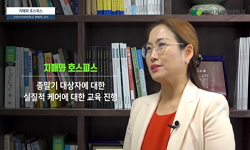This study targeted dementia relief centers in eight major areas (Seoul, Gyeonggi-do, Gwangju, Daejeon, Daegu, Busan, Incheon, and Ulsan) that are conducting prevention and management of dementia. The purpose is to grasp the status of dance programs b...
http://chineseinput.net/에서 pinyin(병음)방식으로 중국어를 변환할 수 있습니다.
변환된 중국어를 복사하여 사용하시면 됩니다.
- 中文 을 입력하시려면 zhongwen을 입력하시고 space를누르시면됩니다.
- 北京 을 입력하시려면 beijing을 입력하시고 space를 누르시면 됩니다.
전국 치매안심센터 무용프로그램 활동 현황-주요 8개 지역 중심으로- = Current state of Dancing programs at Dementia Care Centers in Korea- Focused on Eight Major Regions -
한글로보기https://www.riss.kr/link?id=A108490366
- 저자
- 발행기관
- 학술지명
- 권호사항
-
발행연도
2020
-
작성언어
Korean
-
주제어
치매 ; 치매노인 ; 치매관리 ; 무용프로그램 ; 치매안심센터 ; Dance program ; dementia ; Dementia Care Centers ; elderly
-
자료형태
학술저널
-
수록면
23-38(16쪽)
- DOI식별코드
- 제공처
-
0
상세조회 -
0
다운로드
부가정보
다국어 초록 (Multilingual Abstract)
The frequency of the dance program operation should be extended to more than 2-3 times a week for effective dementia management, and long-term and continuous execution should be carried out. As for the contents of the dance program, silver gymnastics is more than a majority, so various programs should be developed.
This study targeted dementia relief centers in eight major areas (Seoul, Gyeonggi-do, Gwangju, Daejeon, Daegu, Busan, Incheon, and Ulsan) that are conducting prevention and management of dementia. The purpose is to grasp the status of dance programs by institution. The research method was to analyze the subjects, frequency, and content of dance programs in eight major dementia support centers after acquiring papers, books, and periodicals related to the dementia elderly's dance program cases and current status studies. In addition, the data was analyzed through the contents of the dance program presented on the autonomous district website and telephone interviews with program managers. As a result, 76 of the dementia relief centers in the eight major regions did not conduct dance programs, and despite the results of studies showing that dance has various positive effects on the elderly with dementia, they showed inadequate on-site application rates. Also, the dance program targets were executed differently by region, which suggests that systematic program improvement is needed by subdividing the targets.
The frequency of the dance program operation should be extended to more than 2-3 times a week for effective dementia management, and long-term and continuous execution should be carried out. As for the contents of the dance program, silver gymnastics is more than a majority, so various programs should be developed.
동일학술지(권/호) 다른 논문
-
DMZ 세계유산 등재 논의 성과와 과제: 남북 문화유산 정책포럼을 중심으로
- 국제문화&예술학회
- 심승구 ( Shim Seung-koo )
- 2020
-
- 국제문화&예술학회
- 유대용 ( You Dae-yong )
- 2020
-
전국 치매안심센터 무용프로그램 활동 현황 : 주요 8개 지역 중심으로
- 국제문화&예술학회
- 김예원 ( Kim Ye-won )
- 2020
-
- 국제문화&예술학회
- 송미숙 ( Song Mi-sook )
- 2020




 KCI
KCI






